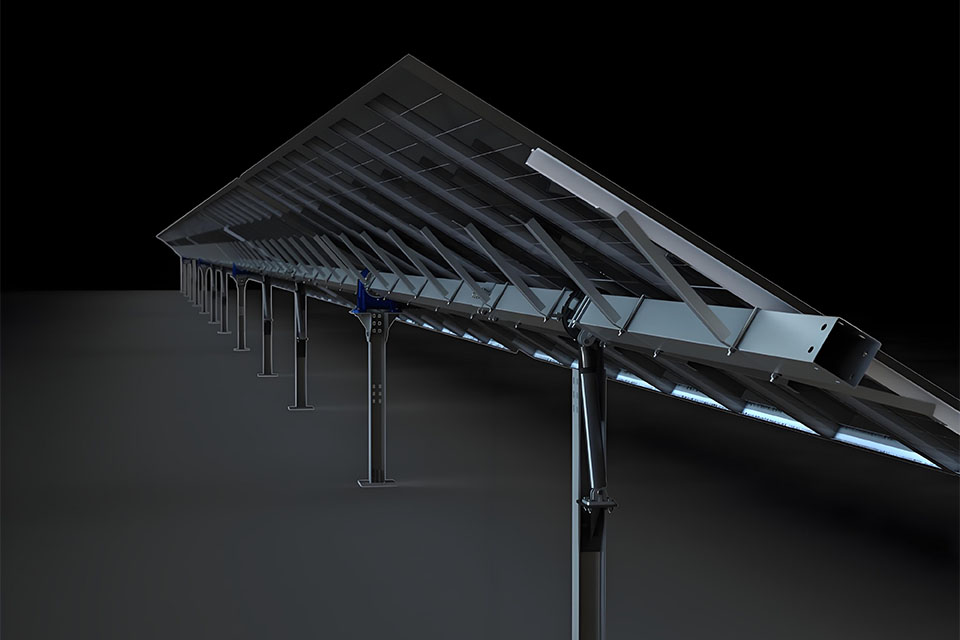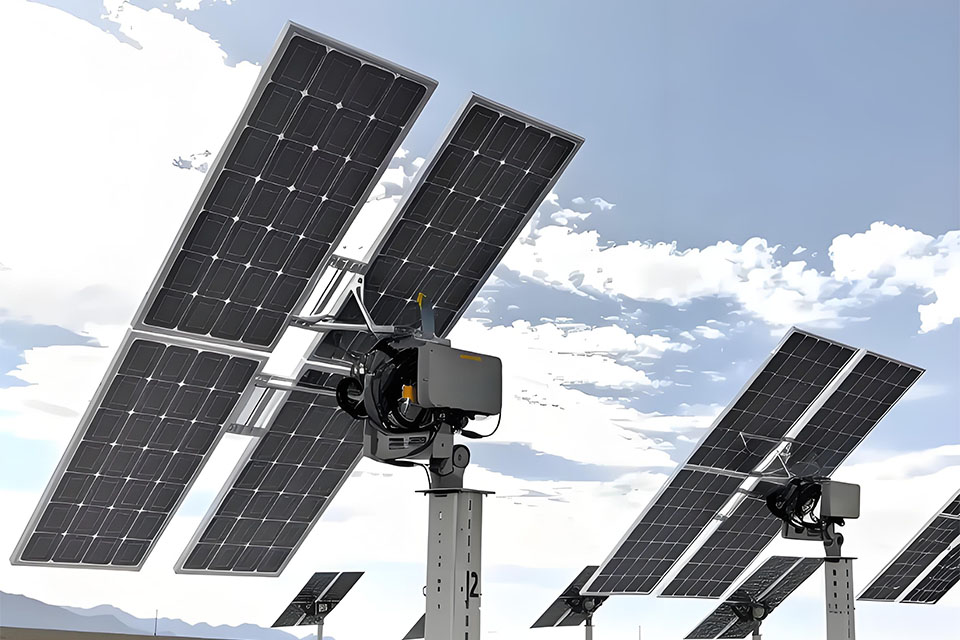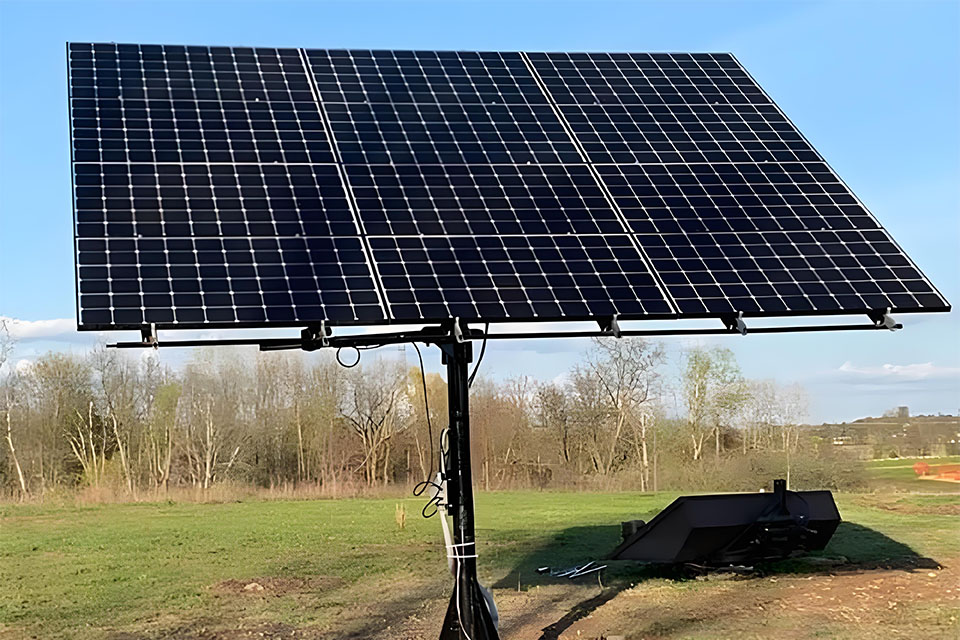태양광 발전소는 패널만으로는 성공할 수 없습니다. 햇빛을 균일하고 제어 가능한 메가와트시로 바로 전환할 수 있는 전체 환경이 필요합니다. 그 중심에 바로 트래커가 있습니다. 추적기는 구성 요소를 햇빛에 맞춰 정렬하고, 제조 윤곽을 개발하며, 훨씬 적은 위험으로 LCOE 목표를 달성할 수 있도록 지원합니다.
환경을 매핑하고, 트래커가 바늘의 위치를 측정하고, 실제 작업에서 SolPath가 어떻게 차이를 만드는지 정확히 보여드리겠습니다.

태양광 생태계에서 트래커가 중요한 이유
최저 비용으로 예측 가능한 에너지를 공급하기 위해 태양광 발전소를 개발합니다. 고정식 틸트 어레이는 테이블에 전력을 남깁니다. 단축 트래커는 틸트 처리 대비 15~25%의 훨씬 더 많은 수익을 제공합니다. 이중 축 시스템은 위도와 애플리케이션에 따라 더 높은 수익을 얻을 수 있습니다. 이러한 이득은 독립적인 표준에 따라 LCOE를 낮추고 그리드 친화적인 결과 프로파일을 개선하여 축소 불편을 최소화합니다.
스마트 백트래킹을 사용하여 행간 음영 손실을 방지하는 포맷을 사용하면 용지를 확장하거나 DC 용량을 과도하게 구축하지 않고도 더 많은 인터넷 에너지를 확보할 수 있습니다. 이것이 바로 오늘날 여러분이 활용할 수 있는 지렛대입니다.

최신 태양광 발전소의 핵심 구성 요소
태양광 모듈: 전력 생산자
- 단결정 및 다결정 실리콘 제어 유틸리티 스케일. 양면 모듈에는 향상된 접지 알베도로 트래커 레이아웃의 후면 이득이 포함됩니다.
- 페로브스카이트와 박막 필름은 가능성을 보이지만, 은행권에서는 여전히 신뢰성과 보증을 위해 결정형 부품을 선호합니다.
- 유틸리티 플랜트에서는 메인 또는 고전력 스트링 인버터를 사용합니다. 둘 다 효율성과 적합성을 위해 플랜트 수준의 SCADA에 바로 연결됩니다.
- 고급 인버터는 전압 라이드스루, 무효 전력 및 축소 반응을 지원합니다. 트래커는 인버터 부하를 지원하는 조도 캡처를 원활하게 하여 도움을 줍니다.
- 마운팅 구조물, 트래커, 케이블, 컴바이너 박스, 스위치 기어 및 유가증권은 에너지의 안전한 이동을 유지합니다.
- 트래커는 수리된 랙을 액추에이터, 컨트롤러 및 구동 메커니즘으로 대체하여 바람이 부는 상황에서도 안전하게 보관하면서 태양을 따라갈 수 있습니다.
- 리튬이온 및 플로우 배터리는 플랜트 가치를 변화시킵니다. 트래커는 ESS에 온난화 시간당 추가 kWh를 공급하여 왕복 경제성 및 그리드 솔루션을 개선합니다.
- SCADA에는 계측기, 기상 조건 터미널, 인버터, 트래커 컨트롤러가 통합되어 있습니다. 성능 저하를 빠르게 감지합니다. 원격 장치로 훨씬 빠르게 예약할 수 있습니다. O&M 중 트럭 롤을 최소화합니다.
인버터: 그리드 기술을 사용한 DC-에어컨
시스템 잔액(BoS): 명예롭지 못한 기초
에너지 저장(ESS): 유연성 및 수익 창출
제어 및 모니터링: 데이터는 곧 경쟁력입니다
트래커의 활용 분야: 전략적 역할
태양광 추적기의 작동 방식
트래커는 태양의 일주 경로에 맞춰 구성 요소 행을 회전합니다. 단일 축 시스템은 웹사이트 위도에 따라 기울기가 향상되어 동쪽에서 서쪽으로 추적합니다. 이중 축에는 최적의 캡처가 필요한 틈새 사용 사례나 오프그리드 계정 세부 정보를 위한 수직 기울기가 포함됩니다.
액티브 시스템은 컨트롤러, 모터, 센서를 활용합니다. 스마트 알고리즘이 천문학적인 설계로 배치를 계산합니다. 기상 조건 입력, 바람 경보 시스템, 줄 점검 피드 제어 로직. 백트래킹 알고리즘은 태양의 각도를 줄여 줄을 피벗하여 줄 간 음영을 피하고 아침과 늦은 오후의 수익을 보장합니다.
실질적인 이점
- 더 높은 에너지 수율. 대부분의 유틸리티 작업에서 단일 축과 고정 틸트를 비교했을 때 15~25%의 이득을 기대할 수 있습니다. 특정 지역에서는 이중 축이 더 많은 이점을 제공할 수 있습니다.
- LCOE 절감. 연간 kWh당 추가 비용과 비슷한 수준의 운영 비용으로 MWh당 비용을 절감할 수 있습니다. 이는 PPA 및 공급업체 기술을 향상시킵니다.
- 더 매끄러운 결과. 추적을 통해 하루 동안의 피크와 밸리 간 변동 폭을 좁혀 그리드 통합 및 축소 관리에 도움이 됩니다.
- 원격 커미셔닝으로 에너지 전환 시간을 최소화합니다. OTA 펌웨어 업그레이드를 통해 웹사이트 중단 없이 기존 차량을 유지할 수 있습니다.
- 통합 SCADA 및 적응형 통신(LoRa, Zigbee, RS485)은 EMS 및 클라우드 분석에 대한 정보 경로를 간소화합니다.
- 윈드 스토우 기술은 폭풍우 시 구조물의 불안감을 줄여줍니다. 지형 내성 제어는 경사가 있거나 고르지 않은 지형에서 추적을 강화합니다.
- 복잡한 지형에서는 행간 음영이 발생합니다. 강력한 백트래킹이 없으면 웹 성능이 저하되고 핫스팟이 발생하게 됩니다.
- 혹독한 기후는 기계와 전자 장치에 압력을 가합니다. 열, 먼지, 추위, 눈을 견딜 수 있도록 설계된 컨트롤러, 씰, 드라이브가 필요합니다.
- 건설 일정이 촉박해집니다. 수작업 커미셔닝은 며칠을 낭비하고 수천 개의 행에 걸쳐 불균형을 초래합니다.
- 제어가 취약하면 O&M 예산이 증가합니다. 잘못된 진단은 차량 롤링으로 이어져 ROI를 떨어뜨립니다.
O&M을 변경하는 고급 속성
무시할 수 없는 프로젝트 리스크
훨씬 더 나은 트래커 제어, 더 깨끗한 데이터, 원격 우선 운영을 통해 이러한 위험을 관리할 수 있습니다.
실용적인 프레임워크: 트래커를 사용한 설계 및 배포
- 부지 분석 및 지반 점검
- 흙 코스를 검증하고 기초 종류(박은 강철 말뚝, 콘크리트 더미, 나선형 말뚝)를 선택합니다. 드라이브 토크를 기초 강성에 맞춥니다.
- 경사 및 지형 기복을 평가합니다. 행 간 음영을 모델링하고 블록별 백트래킹 방법을 정의합니다.
- 시스템 설계 및 레이아웃
- 행 길이, 행 간 간격 및 높이를 설정하여 토지 사용, 차폐 및 케이블 코스를 안정화하세요.
- 기후 및 유지보수 계획에 맞는 액추에이터 유형과 드라이브 스타일을 선택합니다. 컨트롤러 전원 공급 장치(에어컨 공급, 스트링 전원 또는 독립 패널과 배터리)를 확인합니다.
- 조합 및 사이버 보안 상태 제어
- RS485 또는 무선을 사용하여 트래커 컨트롤러를 SCADA에 연결합니다. 네트워크를 섹션화하고 역할 기반 접근성을 적용합니다.
- 기상 관측소와 바람 경보 시스템을 통합하여 적재 추론을 트리거하세요. 은행성 및 보증 적합성을 위해 이벤트를 기록하세요.
- 건설 및 원격 시운전
- 전기 배선 하니스 및 제어 보드 형식을 표준화하세요. 일괄 업데이트 및 점검을 통해 원격으로 행을 커미셔닝하세요.
- 센서 입력 및 스토우 기능의 유효성을 검사합니다. 렙 블록에서 일출/일몰 역추적 보정을 실행합니다.
- O&M 및 지속적인 최적화
- 차량 분석을 사용하여 궤도를 벗어난 행이나 비정상적인 토크를 표시하세요. OTA 펌웨어 업데이트를 통해 다운타임 없이 알고리즘을 강화하세요.
- 계절별 바람과 눈 패턴에 따라 예방적 유지 관리를 조정하세요. 월별로 일정 메트릭을 추적하세요.
솔패스가 더 나은 해답인 이유
우리는 진우 쑤안후이 테크놀로지(Jinwu Xuanhui Technology Co., Ltd.)의 솔패스 브랜드로 스마트 태양광 트래커를 설계, 제작 및 생산합니다. 당사는 트래커, 컨트롤러, 마운팅 시스템 등 전체 공급망을 다룹니다. 기계, 전자 및 소프트웨어 애플리케이션에 대한 답변을 제공하는 단 하나의 동반자를 만나보세요.
SolPath를 차별화하는 요소:
- 그림자 방지 백트래킹. 유니티의 제어 공식은 복잡한 표면에서 행간 음영 손실을 줄여 순복귀와 미관상 핫스팟의 위험을 줄여줍니다.
- 원격 우선 작업. 원격 커미셔닝을 통해 더 빠르게 온라인에 접속할 수 있습니다. OTA 펌웨어 업그레이드로 시간이 지남에 따라 추적 습관과 보호 위치가 향상됩니다.
- 유연한 전원 및 통신. 컨트롤러는 에어컨 공급, 스트링 전원, 전용 태양광 및 배터리 백업 등 다양합니다. 연결 옵션은 RS485 및 무선 프로토콜로 구성되며 SCADA 스타일에 맞게 선택할 수 있습니다.
- 글로벌 문제를 위해 제작되었습니다. 트래커는 경사진 지형과 양면 구성 요소를 지원합니다. 바람막이 및 환경 보호 기능은 따뜻함, 먼지, 추위, 눈 속에서도 신뢰성을 유지합니다.
- 경제적이고 안전한 맞춤형 서비스. 드라이브 옵션, 컨트롤러 배치, 설치를 고객의 웹사이트와 예산 계획에 맞게 맞춤화합니다.
- 수확량 상승. 독립적인 연구에 따르면 단일 축 트래커는 위도와 기후에 따라 기울기를 관리할 때보다 일반적으로 15~25%의 에너지를 증가시키는 것으로 나타났습니다. 이중 축 시스템은 특정 사용 상황에서 더 큰 이득을 얻을 수 있습니다.
- LCOE 개선. 국제 가격 분석에 따르면 5~10%의 LCOE 절감은 트래커 플랜트에서 훨씬 더 나은 전력 포집 및 향상된 플랜트 성능과 관련이 있습니다.
- 표준 및 신뢰성 맥락. 은행 엔지니어는 트래커 설계 검증 및 무결성 평가를 위해 IEC 62817을 사용합니다. 표준 산업 프로토콜에 따른 SCADA 조합은 뱅킹 및 감사 트랙을 지원합니다.
- 컨트롤러 레이아웃 및 커뮤니티 적합성. SolPath 트래커 컨트롤러는 멀티포인트 드라이브 레이아웃, 원격 진단, 플랜트 감시와의 결합을 지원하여 에너지 전환 시간을 단축하고 O&M 노출을 줄입니다.
- 지반 기초 및 구동 토크 추정치를 확인합니다.
- 블록별로 모델 차폐 및 행간 역추적 정책을 설정합니다.
- 컨트롤러 전원 기술(A/C, 스트링 전원 또는 독립형 태양광 플러스 배터리)을 선택합니다.
- 통신(RS485, LoRa, ZigBee) 및 SCADA 정보 매핑을 지정합니다.
- EPC와 함께 윈드 스토우 제한 및 선별 처리를 정의하세요.
- 블록별 전기 배선, 액추에이터 및 제어 캐비닛 형식을 표준화하세요.
- 원격으로 행을 커미셔닝하고 알람을 확인하고, 저장하고, 역추적하세요.
- OTA 펌웨어 케이던스 및 수정 제어 절차를 설정합니다.
- 접근성 목표를 설정하고 일주일에 한 번씩 웰빙 보고서를 추적합니다.
- 진단, 위험 없는 잠금, 폭풍 절차에 대해 O&M 그룹을 교육하세요.
- 트래커는 PV 환경의 주요 요소입니다. 트래커는 에너지를 증가시키고 그리드 친화성을 높입니다.
- 스마트 백트래킹 안전장치는 복잡한 표면에서 반환되어 은행 가능한 kWh를 높입니다.
- 원격 커미셔닝 및 OTA 펌웨어를 통해 에너지 및 O&M 비용을 절감할 수 있습니다.
- SolPath는 트래커, 컨트롤러 및 설치를 다루며 배포와 지원을 간소화합니다.
- IEC 62817 컨텍스트에 맞게 설계하고 SCADA와 통합하여 안정적인 절차 및 깔끔한 감사 트랙을 확보하세요.
- 유틸리티 범위를 위해 제작된 지능형 태양광 추적기를 살펴보세요: 유틸리티 스케일 추적기
- 그림자 방지 추적 및 부품을 확인하세요: 추적기 구성 요소
- 약속 시간을 단축하고 O&M을 강화하세요: 설치 유지 관리
- 상업용 프로젝트의 단일 축 스타일을 비교하세요: 단일 축-64P: 64패널 단일 축 추적 시스템
- 스마트 컨트롤러 및 OTA 업데이트에 대해 알아보세요: 스마트 트래커
- 솔패스 태양광 추적기 시리즈 데이터시트(HYP-HYX-HYS). pdf.md. 데이터 베이스 ID: 658d9b16-dc9d-46ff-8c7b-bfd95b457c8a.
- SolPath 태양광 추적 컨트롤러 시리즈 제품 소개(AC-DC-스트링-멀티포인트 드라이브). pdf.md. 기술 자료 ID: bfc87165-fd7b-44eb-bc73-0684426caff6.
- 솔패스 태양광 추적기 제품 설명서(단일 및 이중 축). pdf.md. 데이터베이스 ID: 892a0c52-c6bd-497e-8941-84aec225ffe0.
- NREL. 태양열 레이더 및 성능 효과. 시장 개요 리소스 https://www.nrel.gov/.
- IRENA. 2023년 재생에너지 발전 비용. https://www.irena.org/
- IEC 62817. 태양 추적기의 스타일 자격. 국제 전기 기술 위원회.
은행에 가져갈 수 있는 증거
비교: 고정 틸트 대 단일 축 대 이중 축 비교
| System Type | 에너지 수율 대 고정 기울기 | CAPEX | OPEX | Terrain Tolerance | Best Use Case |
|---|---|---|---|---|---|
| Fixed-Tilt | 기준선 | 가장 낮은 | 가장 낮은 | 높은 | 협소한 부지, 매우 강한 바람, 초저 CAPEX |
| Single-Axis Tracker | 일반 +15-25% | 보통의 | 보통의 | 역추적 기능으로 높음 | 유틸리티 규모, 넓은 위도, 균형 잡힌 LCOE |
| Dual-Axis Tracker | 일부 지역에서 더 높음 | 더 높은 | 더 높은 | 보통의 | 최대 캡처 또는 오프그리드 프로필이 필요한 틈새 사이트 |
참고: 수확량 품종은 일반적인 업계 결과를 나타냅니다. 실제 수확량은 위도, 알베도, 음영 및 식물 배치에 따라 달라집니다.
배포 체크리스트: 올바른 트래커 배포

실제 경험: 현장에서 볼 수 있는 것
경사진 땅에서는 햇빛 각도가 낮을 때 줄 오프셋이 급격하게 변하는 것을 볼 수 있습니다. 그림자 방지 백트래킹은 앞줄의 음영이 검사 결과에 영향을 미치지 않도록 방지합니다. 건조한 지역에서는 액추에이터 씰과 컨트롤러 전자 장치를 검사하는 먼지와 온기와 싸워야 합니다. 원격 커미셔닝을 통해 제어 공간에서 수천 개의 행을 온라인 상태로 전환할 수 있습니다. OTA 업그레이드는 차량을 굴리지 않고도 주변 날씨 패턴에 맞게 알고리즘을 조정합니다.
추운 기후에서는 눈이 오면 적재 및 보안 재부팅 추론이 트리거됩니다. 컨트롤러는 보증 및 규정 준수를 위해 상황과 상태를 기록해야 합니다. 축소 상황이 발생하면 인버터가 트립되지 않도록 예측 가능한 제어와 원활한 복구가 필요합니다. 트래커는 조도 캡처를 일관되게 유지하여 식물의 습관을 유지하는 데 도움을 줍니다.
행동 유도: 생각하는 트래커로 LCOE 절감
유틸리티 규모의 태양광 발전소를 준비 중이거나 차폐 및 표면 문제가 있는 부지에 전력을 재공급하는 경우 도움을 드릴 수 있습니다. 웹사이트 형식과 행 간 간격을 보내주세요. 그림자 방지 백트래킹, 원격 예약, OTA 대비 기능을 갖춘 트래커 설계 및 제어 계획을 제공해 드립니다.
주요 내용
자주 묻는 질문
태양광 트래커는 추가 비용을 지불할 가치가 있나요?
많은 유틸리티 규모의 웹사이트에서 단축 트래커는 틸트를 처리하는 것보다 15~25% 훨씬 더 많은 전력을 제공하여 LCOE를 낮추는 경우가 많습니다. 중위도 지역과 백트래킹 제어로 차폐 손실을 방지할 수 있는 웹사이트에서는 상황이 더 심각해집니다.
트래커에 필요한 유지 관리 요건은 무엇인가요?
전략 예방 검사 액추에이터, 드라이브, 컨트롤러 유닛을 검사합니다. SCADA 진단을 사용하여 궤도를 벗어난 행을 조기에 감지합니다. OTA 펌웨어 업데이트로 웹사이트 방문 없이 제어 로직을 개선하여 O&M을 줄입니다.
기존 태양광 발전소를 트래커로 개조할 수 있나요?
레트로핏은 기초, 케이블, 인버터 설계가 트래커 역학 및 제어를 지원할 수 있을 때 작동합니다. 음영 및 지질 공학 연구 조사를 통해 타당성을 확인합니다. 원격 예약을 통해 단계적 컷오버를 간소화할 수 있습니다.
트래커는 바람과 폭풍을 어떻게 처리하나요?
컨트롤러는 설정된 한도에 따라 바람 알람을 사용하여 적재함을 작동시킵니다. 드라이브는 안전한 각도로 이동하여 낮은 주차장으로 이동합니다. 이벤트 로그는 규정 준수 및 보증 절차를 지원합니다.
트래커가 SCADA 및 EMS와 통합되나요?
예. 컨트롤러는 RS485 또는 무선 링크를 통해 연결됩니다. 플랜트는 상태, 알람 및 배치 데이터를 SCADA에 매핑하여 실시간 모니터링 및 효율성 분석을 유지합니다.